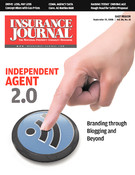Maryland’s private auto insurance industry is objecting to a proposal by the state’s insurer of last resort to lower rates as gasoline and food prices rise.
At a hearing in Baltimore, industry representatives told Insurance Commissioner Ralph Tyler that the Maryland Automobile Insurance Fund’s plan to make coverage more affordable puts the private sector and the state fund at risk.
The General Assembly created MAIF in 1972 after making auto insurance compulsory to provide auto insurance to drivers rejected by private companies. But private insurers must bail out the fund if there are major financial problems.
The state-controlled fund wants to reduce rates by an average of about $120 per policy. The average MAIF policy is about $2,400 a year.
“What we find is that most of the people that come to us are working families,” Executive Director M. Kent Krabbe said. “We insure people who are struggling and to the extent that we can help out, we want to.”
But MAIF’s discount is “actuarially unsound” and could put the state fund at risk for insolvency, said Richard Stokes, a regional manager with the Property Casualty Insurers Association of America.
‘Not Going to Happen’
Krabbe dismissed that suggestion. “We would have to lose $140 million in order to be in a position of insolvency,” Krabbe said. “That’s like saying nuclear war has broken out and life on earth has ended as we know it. That’s just not going to happen.”
The state fund, which has a $170 million surplus, provides more than 65,000 insurance policies and wrote about $120 million in premiums in 2007. The discount would reduce premiums by less than $6 million a year.
Some private insurers are also worried about competition. The state requires that MAIF only provide coverage to drivers rejected by two private companies. But it doesn’t enforce that requirement strictly enough, said Hal S. Katz, president of Baltimore-based Interstate Auto Insurance Co., which specializes in high risk drivers.
“Would you want a state-operated entity to all of a sudden be a major competitor in the marketplace?” Katz said. “If there was enforcement … I would probably have never lodged the protest.”
Meanwhile, Progressive Insurance has figured out a way to price according to driving behavior and is introducing a car insurance program in Maryland that offers lower rates on cars that are driven in less risky ways.
“MyRate is designed for consistent and safe drivers,” said Richard Hutchinson, Progressive’s MyRate general manager. “It’s for people who drive at low risk times of day and who keep alert for others on the road. They don’t make fast lane changes or follow too closely behind other drivers so they don’t have to over-react or slam on the brakes.”
Drivers who sign up for MyRate receive a wireless device to plug into a port in their car that allows Progressive to see how, how much, and when the car is being driven. Cars driven less often, in less risky ways and at less risky times of day can receive a lower premium.
New Maryland customers can earn a first-term discount of up to 10 percent just for signing up. Then, when they renew their policy, they could earn a discount of up to 25 percent or more based on their driving habits. There is also a $30 technology expense each policy period for the wireless device.
Progressive’s initial foray into usage-based insurance started in 1999 in Texas with a plan called Autograph. It then piloted another plan, TripSense, in Minnesota, Michigan and Oregon beginning in 2004. The latest program, MyRate, is being rolled out countrywide.
Massachusetts Green
Also, Boston-based Plymouth Rock Assurance Corp. said it will reward its auto insurance customers in Massachusetts with lower rates for driving less. Plymouth Rock will lower rates for customers who drive fewer miles than the average customers in their geographic area.
Plymouth Rock offers a standard low-mileage discount, but it now also provides an additional reward to those who drive fewer miles than their neighbors, by examining the average mileage for drivers in the type of geographic area in which they live (rural, suburban, inner suburban or urban), based on individual vehicle mileage records collected by the state Registry of Motor Vehicles.
Policyholders who drive as little as 15 percent below the average can see their rates go down by as much as 15 percent.
The “pay-as-you-drive” idea is also being debated in California, where state insurance regulators have proposed regulations that would link premiums more closely with the number of miles driven. An Oct. 20 hearing has been scheduled.
Was this article valuable?
Here are more articles you may enjoy.


 AIG Files Amended Suit Against Former Execs, Dellwood Insurance
AIG Files Amended Suit Against Former Execs, Dellwood Insurance  Allstate Reports Second Quarter Pretax Catastrophe Losses of $2.1B
Allstate Reports Second Quarter Pretax Catastrophe Losses of $2.1B  Beryl’s Remnants Spawned 4 Indiana Tornadoes, Including an EF-3: NWS
Beryl’s Remnants Spawned 4 Indiana Tornadoes, Including an EF-3: NWS  Surplus Lines Commercial Growth; Fla. Litigation Costs Reach New High in 2023
Surplus Lines Commercial Growth; Fla. Litigation Costs Reach New High in 2023 


